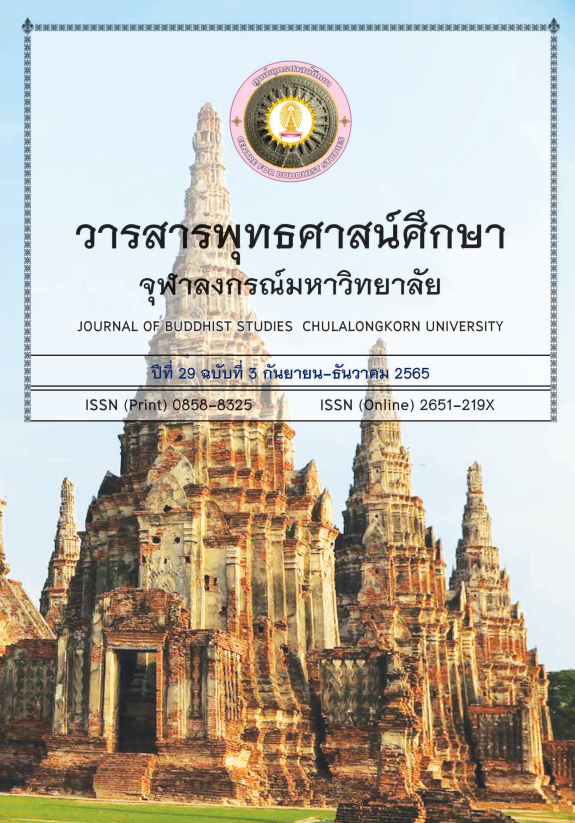“Cetanā” And “Kamma” in Theravāda Buddhism
Keywords:
Cetanā, Kamma, Mind, Mental factor, Cetanā-cetasikaAbstract
This research article studies the concept of intention (cetanā) in relation with kamma in Theravāda Buddhism by exploring whether the statement “cetanā is kamma” found in the Sutta points to the universal mental factor called intention (cetanā-cetasika) in the Abhidhammi c analysis. The study finds that cetanā as kamma does not signify the mental factor called intention. Rather, it signifies a volitional cluster where conscious minds, universal intentional mental factors, and various particular wholesome or unwholesome mental factors co-arise and co-operate in shaping 29 mind-patterns whose functions are to be aware of a perceived object in the stream of consciousness. Many conditions are required to make a flow of volition a kammic action. First, there must be sense-consciousness. Then the object must be strongly perceived and repetitively run through by seven conscious minds. Also, the intentional mental factor must cooperate with particular wholesome or unwholesome mental factors to put forth particular fruits (vipāka) which are capable of determining the moral values in successive moments.
Downloads
References
คณะกรรมการแผนกตํารา. (2557). อภิธัมมัตถสังคหบาลีและอภิธัมมัตถวิภาวินีฎีกา ฉบับแปลเป็นไทย. กรุงเทพมหานคร: โรงพิมพ์มหามกุฎราชวิทยาลัย.
จักเรศ อิฐรัตน์. (2550). กรรมที่ทําตามหน้าที่มีวิบากหรือไม่. วารสารพุทธศาสน์ศึกษา จุฬาลงกรณ์มหาวิทยาลัย, 14(1), 8-35.
พระธรรมปิฎก (ป. อ. ปยุตโต). (2538). พจนานุกรมพุทธศาสตร์ ฉบับประมวลธรรม. กรุงเทพมหานคร: มหาจุฬาลงกรณราชวิทยาลัย.
ประกายแก้ว งานทวี. (2550). การศึกษาเชิงวิเคราะห์หลักกรรมตามนัยพระอภิธรรม (วิทยานิพนธ์ศิลปศาสตรมหาบัณฑิต สาขาวิชาพุทธศาสนศึกษา, มหาวิทยาลัยธรรมศาสตร์).
พระปลัดวิสุทธิ์ คุตตชโย. (2555). คู่มือการศึกษา พระอภิธรรมชั้นอูฬอาภิธรรมิ กะตรี. กรุงเทพมหานคร: มูลนิธิสัทธัมมโชติกะ.
พระสัทธัมมโชติกะ ธัมมาจริยะ. (2553). ปรมัตถโชติกะ ปริจเฉทที่ 1-2-6 จิต เจตสิก รูป นิพพาน. กรุงเทพมหานคร: มูลนิธิสัทธัมมโซติกะ.
มหาจุฬาลงกรณราชวิทยาลัย. (2539). พระไตรปิฎกภาษาไทย ฉบับมหาจุฬา ลงกรณราชวิทยาลัย เล่ม 22, 24, 25, 34. กรุงเทพมหานคร: มหาจุฬา ลงกรณราชวิทยาลัย.
มหามกุฎราชวิทยาลัย. (2538). พระไตรปิฎกภาษาบาลี ฉบับสยามรัฐ เล่ม 34. กรุงเทพมหานคร: โรงพิมพ์มหามกุฎราชวิทยาลัย.
มหามกุฎราชวิทยาลัย. (2559). พระไตรปิฎกและอรรถกถาภาษาไทย ฉบับมหามกุฎราชวิทยาลัย เล่ม 75, 76. กรุงเทพมหานคร: โรงพิมพ์มหามกุฎราชวิทยาลัย.
มหามกุฎราชวิทยาลัย.(2536).วิสุทธิมรรค แปล ภาค ๓ ตอน ๒. กรุงเทพมหานคร: โรงพิมพ์มหามกุฎราชวิทยาลัย.
มูลนิธิศึกษาและเผยแพร่พระพุทธศาสนา. (2551). อเหตุกกิริยาจิต. สืบค้นจาก https://www.dhammahome.com/webboard/topic/10455.
มูลนิธิศึกษาและเผยแพร่พระพุทธศาสนา. (2551). อเหตุกจิต 18 ดวง. สืบค้นจาก https://www.dhammahome.com/webboard/topic10508.html.
มูลนิธิศึกษาและเผยแพร่พระพุทธศาสนา.(2554). ชวนจิตของผู้ที่ไม่ใช่พระอรหันต์. สืบค้นจาก https://www.dhammahome.com>topic.
มูลนิธิศึกษาและเผยแพร่พระพุทธศาสนา. (2558). นานักขณิกกัมมปัจจัย. สืบค้นจาก https://www.dhammahome.com/audio/topic/5567.
สุจินต์ บริหารวนเขตต์. (2536). ปรมัตถธรรมสังเขป จิตตสังเขป และภาคผนวก. กรุงเทพมหานคร: โรงพิมพ์ชวนพิมพ์.
สุมาลี มหณรงค์ชัย. (2564). ข้อถกเถียงทางปรัชญาเกี่ยวกับเรื่อง “กรรม” ในพระพุทธศาสนาเถรวาท (รายงานวิจัยในโครงการวิจัย พุทธศาสน์ศึกษา, ศูนย์พุทธศาสน์ศึกษา จุฬาลงกรณ์มหาวิทยาลัย).
Downloads
Published
How to Cite
Issue
Section
License
Copyright (c) 2022 Chulalongkorn University Centre for Buddhist Studies

This work is licensed under a Creative Commons Attribution-NonCommercial-NoDerivatives 4.0 International License.
บทความที่ได้รับการตีพิมพ์เป็นลิขสิทธิ์ของศูนย์พุทธศาสน์ จุฬาลงกรณ์มหาวิทยาลัย
ข้อความที่ปรากฏในบทความแต่ละเรื่องในวารสารวิชาการเล่มนี้เป็นความคิดเห็นส่วนตัวของผู้เขียนแต่ละท่านไม่เกี่ยวข้องกับศูนย์พุทธศาสน์ จุฬาลงกรณ์มหาวิทยาลัย และคณาจารย์ท่านอื่นๆในมหาวิทยาลัยฯ แต่อย่างใด ความรับผิดชอบองค์ประกอบทั้งหมดของบทความแต่ละเรื่องเป็นของผู้เขียนแต่ละท่าน หากมีความผิดพลาดใดๆ ผู้เขียนแต่ละท่านจะรับผิดชอบบทความของตนเองแต่ผู้เดียว






